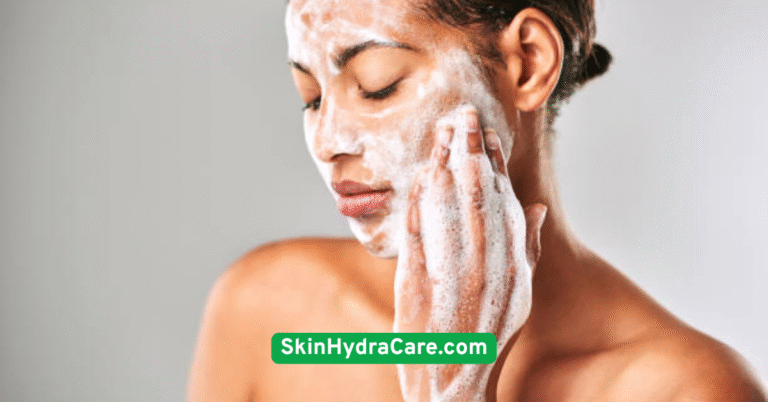10 Soothing Skincare Tips for Dry Skin (2025 Edition)

1. Choose a Gentle, Fragrance-Free Cleanser
Many people don’t realize that their cleanser could be the culprit behind their dry, irritated skin. Harsh surfactants, artificial fragrances, and stripping ingredients can wreak havoc on your skin barrier. The result? Flakiness, tightness, and redness.A better approach is choosing a fragrance-free, hydrating cleanser formulated for sensitive or dry skin types. Look for ingredients like glycerin, ceramides, and squalane — all of which help preserve the skin’s natural moisture without stripping its oils.Also, avoid foaming cleansers or anything marketed as “oil control” — these are often too aggressive. Creamy, milky, or balm-based cleansers work beautifully for dry complexions. The simpler, the better!

2. Use Lukewarm Water, Not Hot
Hot showers might feel like heaven, especially in colder months, but they can silently sabotage your skin. Hot water strips away essential oils, leaving your face and body dry and vulnerable. If your skin feels tight after washing, it’s a sign your water temperature is too high.Switching to lukewarm water is a small change with big benefits. It’s gentler, helps maintain the skin barrier, and prevents trans-epidermal water loss — a fancy term for the moisture escaping your skin.Try to limit showers to under 10 minutes, and always end with a hydrating routine while your skin is still damp. That brings us to the next crucial step.

3. Apply Moisturizer While Skin Is Damp
Here’s one skincare hack that dermatologists swear by: moisturize while your skin is still damp. This helps trap water into the skin and locks in hydration more effectively. Waiting too long after washing allows moisture to evaporate — making your products work harder than they need to.Opt for a moisturizer rich in emollients, occlusives, and humectants. Emollients smooth the skin, humectants (like hyaluronic acid) attract water, and occlusives (like petrolatum or shea butter) form a protective seal.A simple routine? Cleanse with lukewarm water, pat your skin slightly (don’t rub), and slather on your moisturizer within three minutes. Your skin will thank you with a hydrated glow.

4. Use a Humidifier at Night
Sometimes, your environment is your biggest skincare enemy. Indoor heating and air conditioning can suck the moisture right out of the air — and your skin. That’s where a humidifier becomes a game-changer.Running a humidifier while you sleep restores the air’s moisture levels, which in turn helps your skin stay hydrated overnight. Aim for a humidity level between 40–60%, especially in winter or dry climates.Want an extra boost? Place your humidifier near your bed or workspace, and use it consistently during colder months. It’s a budget-friendly solution with massive benefits for your skin’s long-term health.

5. Add Hyaluronic Acid to Your Routine
Hyaluronic acid (HA) is like a tall glass of water for your skin. This naturally occurring molecule can hold up to 1000 times its weight in water, making it one of the most effective ingredients for dry skin.Apply a few drops of HA serum to damp skin (this part is key), then layer your moisturizer on top to seal it in. Without this second step, HA can actually pull moisture out of the skin in dry environments.Look for serums that combine HA with panthenol, aloe vera, or niacinamide for added soothing effects. Whether you’re splurging or sticking to a tight budget, there are excellent HA options available for all price points.

6. Avoid Alcohol-Based Skincare Products
It’s easy to fall in love with the tingly “clean” feeling some products give — but that sensation often comes from alcohol-based ingredients that are too harsh for dry skin. These drying alcohols strip your natural oils and damage the skin barrier.Scan product labels for alcohol denat, ethanol, or isopropyl alcohol. Instead, choose alcohol-free toners, serums, and cleansers that focus on hydration and barrier repair.Not all alcohols are bad — fatty alcohols like cetyl and stearyl alcohol can be beneficial. The key is understanding which ones to avoid and which ones to embrace.

7. Try Overnight Hydrating Masks
Your skin regenerates while you sleep, making bedtime the perfect opportunity to apply overnight hydration masks. These leave-on treatments deliver powerful ingredients that sink into the skin over several hours — not just a few minutes.Look for masks with squalane, ceramides, centella asiatica, and niacinamide. These ingredients calm inflammation, repair the skin barrier, and leave your face feeling baby-soft by morning.Apply after your usual nighttime routine as the final step. It’s like a cozy blanket for your skin — and who doesn’t want to wake up glowing?

8. Exfoliate Gently, Not Aggressively
When your skin is dry, exfoliation might sound like the last thing you need. But skipping this step can actually cause more problems — like dullness and product build-up. The trick is to exfoliate gently and not too often.Avoid scrubs with large granules or harsh brushes. Instead, go for chemical exfoliants like lactic acid or enzyme-based formulas — both of which are much gentler on dry skin.Limit exfoliation to 1–2 times per week, and always follow with a rich moisturizer or soothing face oil. Exfoliation helps your products absorb better — but only when done with care.

9. Incorporate Nourishing Facial Oils
Oils might seem intimidating, especially if you’re worried about breakouts. But the right facial oils can be game-changers for dry skin. They help seal in moisture, protect the skin barrier, and reduce irritation.Some of the best oils for dry skin include jojoba, marula, rosehip, and argan oil. These oils are non-comedogenic and rich in fatty acids and antioxidants.Apply a few drops after your moisturizer at night, or mix into your cream for a richer texture. Facial oils aren’t just trendy — they’re deeply effective when used correctly.

10. Stay Hydrated and Eat Skin-Friendly Foods
Skincare doesn’t stop at the bathroom counter — what you eat (and drink) matters too. Dehydration, nutrient deficiencies, and lack of healthy fats can all show up on your skin in the form of dryness and dullness.Make hydration a priority: drink plenty of water and herbal teas throughout the day. Incorporate omega-3-rich foods like salmon, walnuts, and flaxseeds into your meals. Also, load up on fruits and veggies high in vitamin E, C, and zinc.Healthy skin starts from the inside out. When your body is nourished, your skin glows — naturally.

Conclusion
Dry skin doesn’t have to be your daily reality. With a few consistent habits and a little extra love, your skin can feel soft, soothed, and beautifully hydrated all year long. Whether it’s choosing a gentle cleanser, embracing nourishing oils, or adding a humidifier to your space — every step matters.
Remember, the best skincare isn’t always the most expensive. It’s the one that’s kind, consistent, and tailored to your skin’s real needs. So take a deep breath, give your skin the care it deserves, and enjoy that radiant, hydrated glow — one gentle step at a time.





